"A tree is a wonderful living organism which gives shelter, food,
warmth and protection to all living things. It even gives shade to
those who wield an axe to cut it down" - Buddha.
There are probably hundreds of majestic and magnificent trees in the world - of these, some are particularly special:
10. Lone Cypress in Monterey
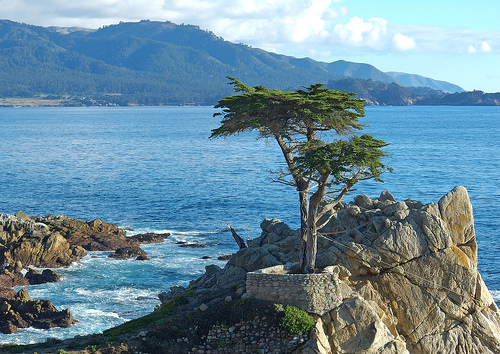
(Image credit: bdinphoenix [flickr])
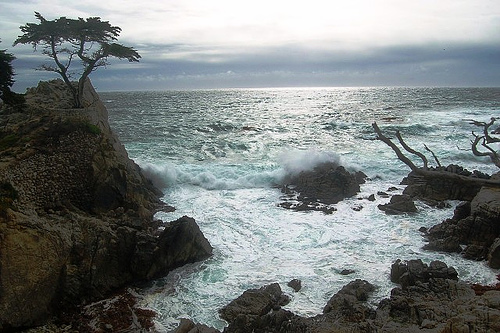
(Image credit: mikemac29 [flickr])
Buffeted by the cold Pacific Ocean wind, the scraggly Lone Cypress [wiki] (Cupressus macrocarpa) in Pebble Beach, Monterey Peninsula, California, isn't a particularly large tree. It makes up for its small size, however, with its iconic status as a stunningly beautiful tree in splendid isolation, framed by an even more beautiful background of the Pacific Ocean.
9. Circus Trees
As a hobby, bean farmer Axel Erlandson [wiki] shaped trees - he pruned, bent, and grafted trees into fantastic shapes and called them "Circus Trees." For example, to make this "Basket Tree" arborsculpture, Erlandson planted six sycamore trees in a circle and then grafted them together to form the diamond patterns.
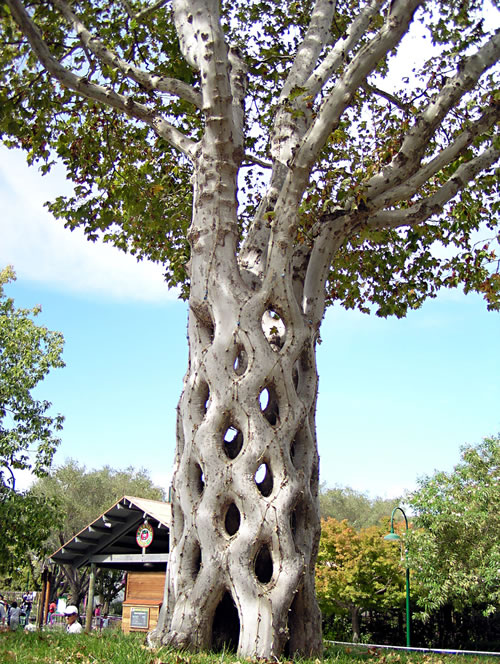
Basket Tree (Image credit: jpeepz [flickr])
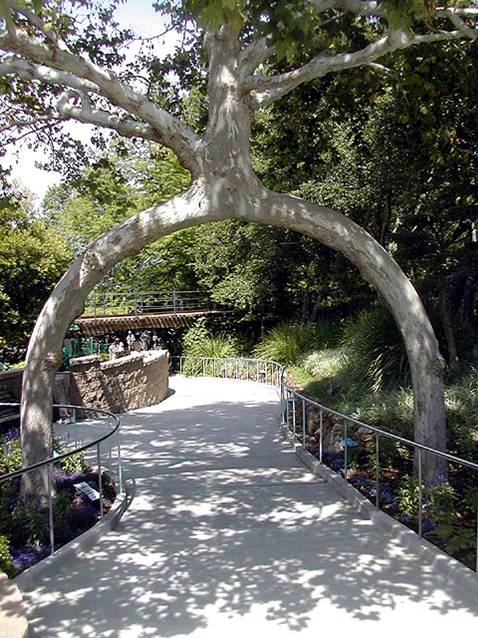
The two-legged tree (Image credit: Vladi22, Wikipedia)
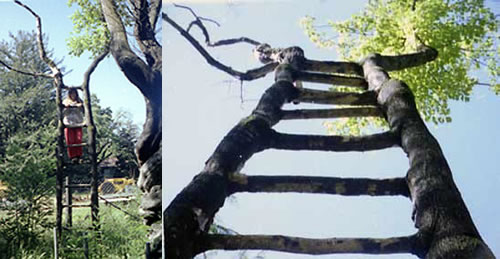
Ladder tree (Image credit: Arborsmith)
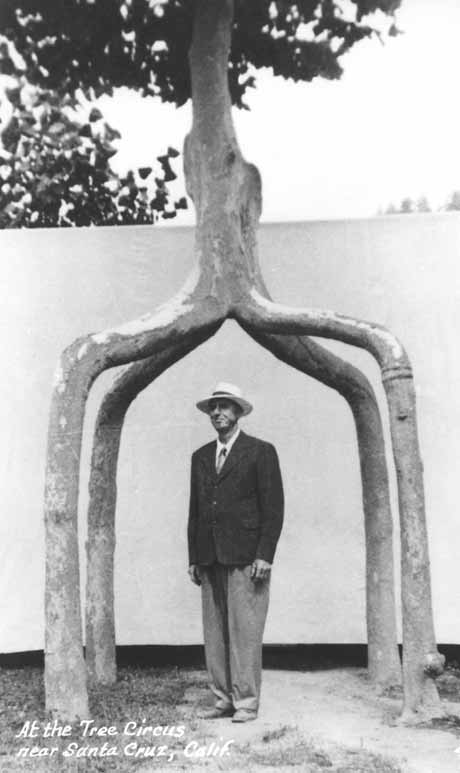
Axel Erlandson underneath one of his arborsculpture (Image credit: Wilma Erlandson, Cabinet Magazine)
Erlandson was very secretive and refused to reveal his methods on how to grow the Circus Trees (he even carried out his graftings behind screens to protect against spies!) and carried the secrets to his grave.
The trees were later bought by millionaire Michael Bonfante, who transplanted them to his amusement park Bonfante Gardens in Gilroy in 1985.
8. Giant Sequoias: General Sherman
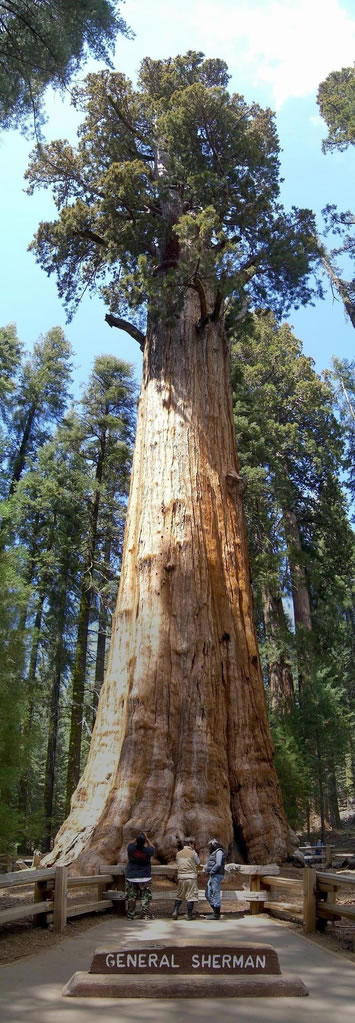
(Image credit: Humpalumpa [flickr])
Giant Sequoias [wiki] (Sequoiadendron giganteum), which only grow in Sierra Nevada, California, are the world's biggest trees (in terms of volume). The biggest is General Sherman [wiki] in the Sequoia National Park - one behemoth of a tree at 275 feet (83.8 m), over 52,500 cubic feet of volume (1,486 m³), and over 6000 tons in weight.
General Sherman is approximately 2,200 years old - and each year, the tree adds enough wood to make a regular 60-foot tall tree. It's no wonder that naturalist John Muir said "The Big Tree is Nature's forest masterpiece, and so far as I know, the greatest of living things."
For over a century there was a fierce competition for the title of the largest tree: besides General Sherman, there is General Grant [wiki] at King's Canyon National Park, which actually has a larger circumference (107.5 feet / 32.77 m vs. Sherman's 102.6 feet / 31.27 m).
In 1921, a team of surveyors carefully measured the two giants - with their data, and according to the complex American Forestry Association system of judging a tree, General Grant should have been award the title of largest tree - however, to simplify the matter, it was later determined that in this case, volume, not point system, should be the determining factor.
7. Coast Redwood: Hyperion and Drive-Thru Trees
 There is another sequoia species (not to be confused with Giant Sequoia) that is quite remarkable: the Coast Redwood [wiki] (Sequoia sempervirens), the tallest trees in the world.
There is another sequoia species (not to be confused with Giant Sequoia) that is quite remarkable: the Coast Redwood [wiki] (Sequoia sempervirens), the tallest trees in the world.
The reigning champion is a tree called Hyperion in the Redwood National Park, identified by researcher Chris Atkins and amateur naturalist Michael Taylor in 2006. Measuring over 379 feet (155.6 115 m) tall, Hyperion beat out the previous record holder Stratosphere Giant [wiki] in the Humboldt Redwoods State Park (at 370 feet / 112.8 m).
The scientists aren't talking about the exact location of Hyperion: the terrain is difficult, and they don't want a rush of visitors to come and trample the tree's root system.
[Image: The Stratosphere Giant - still an impressive specimen, previously the world's tallest tree until dethroned by Hyperion in 2006.]
That's not all that's amazing about the Coast Redwood: there are four giant California redwoods big enough that you can drive your car through them!
The most famous of the drive-through trees is the Chandelier Tree [wiki] in Leggett, California. It's a 315 foot tall redwood tree, with a 6 foot wide by 9 foot tall hole cut through its base in the 1930s.
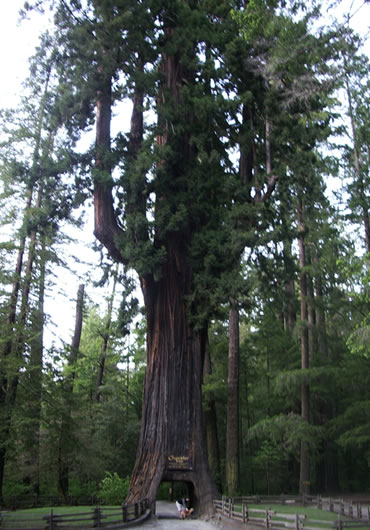
Chandelier Tree. (Image credit: hlh-abg [flickr])
6. Chapel-Oak of Allouville-Bellefosse
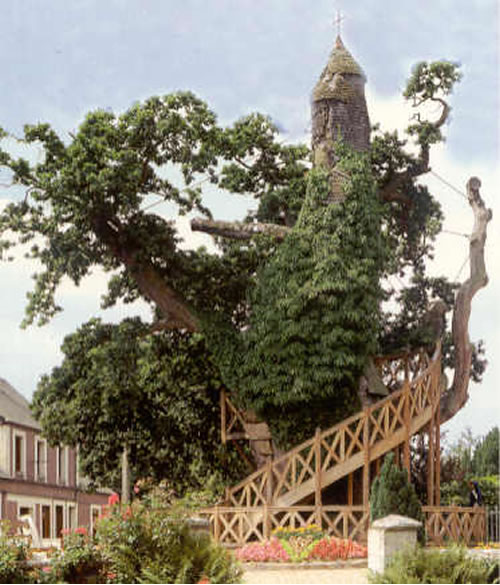
Chapel-Oak of Allouville-Bellefosse (Image credit: Old trees in Netherlands & Europe)
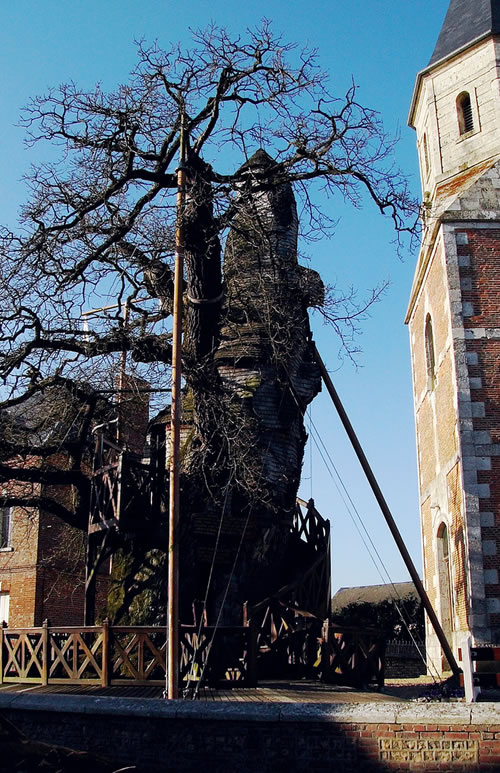
(Image credit: dm1795 [flickr])
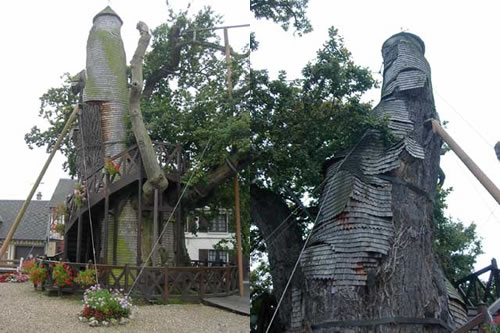
(Image credit: Luc Doudet)
The Chêne-Chapelle (Chapel-Oak) of Allouville-Bellefosse is the most famous tree in France - actually, it's more than just a tree: it's a building and a religious monument all in one.
In 1669, l'Abbe du Detroit and du Cerceau decided to build a chapel in (at that time) a 500 years old or so oak (Quercus robur) tree made hollow by a lightning bolt. The priests built a small altar to the Virgin Mary. Later on, a second chapel and a staircase were added.
Now, parts of the tree are dead, the crown keeps becoming smaller and smaller every year, and parts of the tree's bark, which fell off due to old age, are covered by protective oak shingles. Poles and cables support the aging tree, which in fact, may not live much longer. As a symbol, however, it seems that the Chapel-Oak of Allouville-Bellefosse may live on forever.
5. Quaking Aspen: Pando (The Trembling Giant)
Quaking Aspen (Image: Wikipedia)
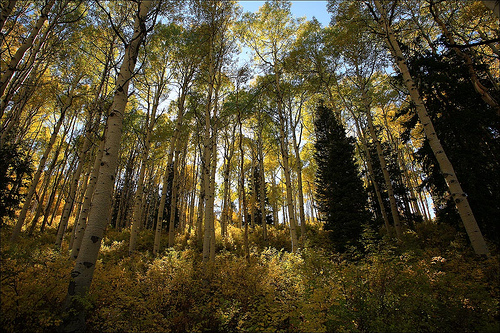
Aspen grove (Image credit: scottks1 [flickr])
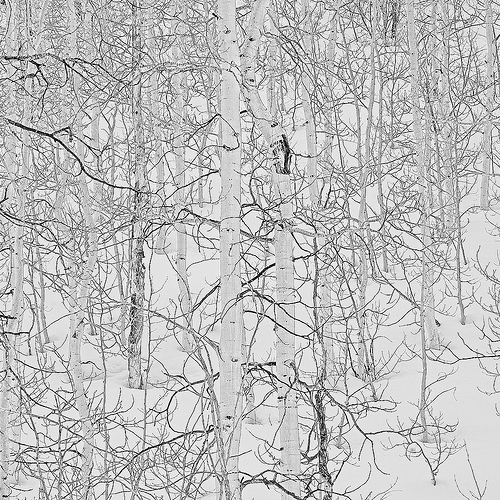
Quaking Aspen in winter (Image credit: darkmatter [flickr])
Pando [wiki] or the Trembling Giant in Utah is actually a colony of a single Quaking Aspen (Populus tremuloides) tree. All of the trees (technically, "stems") in this colony are genetically identical (meaning, they're exact clones of one another). In fact, they are all a part of a single living organism with an enormous underground root system.
Pando, which is Latin for "I Spread," is composed of about 47,000 stems spread throughout 107 acres of land. It estimated to weigh 6,600 tons, making it the heaviest known organism. Although the average age of the individual stems are 130 years, the entire organism is estimated to be about 80,000 years old!
4. Montezuma Cypress: The Tule Tree
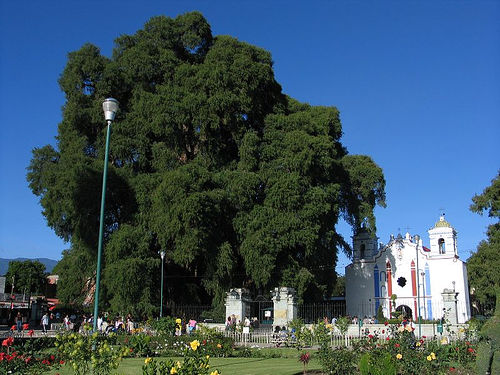
The Tule Tree Towers over a church next to it (Image credit: jubilohaku [flickr])
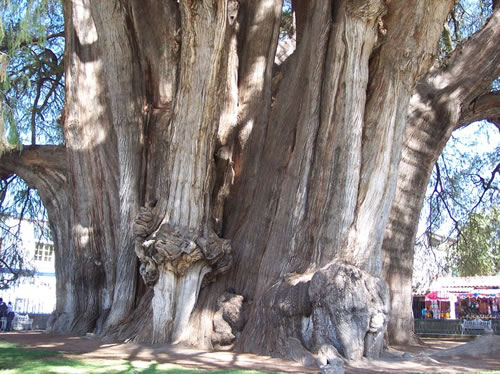
Full width of the Tule Tree (Image credit: Gengiskanhg, Wikipedia)
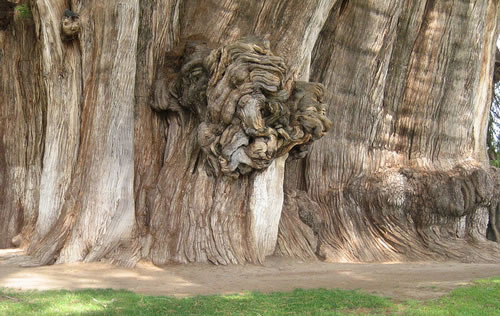
Close-up of the tree's gnarled trunk. Local legends say that you can make out animals like jaguars and elephants in the trunk, giving the tree the nickname of "the Tree of Life" (Image credit: jvcluis [flickr])
El Árbol del Tule [wiki] ("The Tule Tree") is an especially large Montezuma cypress (Taxodium mucronatum) near the city of Oaxaca, Mexico. This tree has the largest trunk girth at 190 feet (58 m) and trunk diameter at 37 feet (11.3 m). The Tule tree is so thick that people say you don't hug this tree, it hugs you instead!
For a while, detractors argued that it was actually three trees masquerading as one - however, careful DNA analysis confirmed that it is indeed one magnificent tree.
In 1994, the tree (and Mexican pride) were in jeopardy: the leaves were sickly yellow and there were dead branches everywhere- the tree appeared to be dying. When tree "doctors" were called in, they diagnosed the problem as dying of thirst. The prescription? Give it water. Sure enough, the tree soon recovered after a careful watering program was followed.
3. Banyan Tree: Sri Maha Bodhi Tree
The Banyan tree is named after "banians" or Hindu traders who carry out their business under the tree. Even if you have never heard of a Banyan tree (it was the tree used by Robinson Crusoe for his treehouse), you'd still recognize it. The shape of the giant tree is unmistakable: it has a majestic canopy with aerial roots running from the branches to the ground.
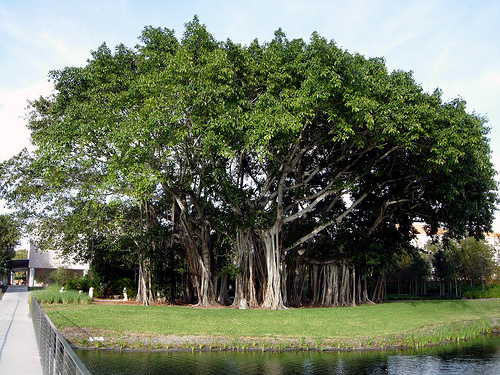
Banyan tree (Image credit: Diorama Sky [flickr])
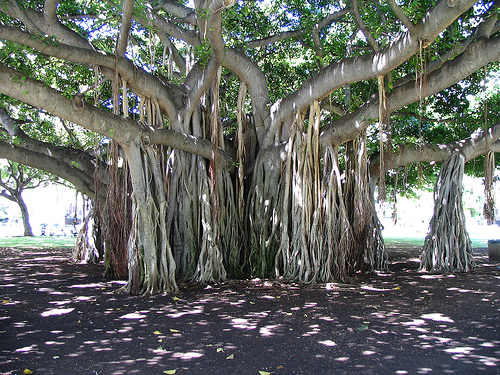
Closer view of the Banyan aerial root structure (Image credit: BillyCrafton [flickr])
If you were thinking that the Banyan tree looks like the trees whose roots snake through the ruins of the Ta Prohm temple like tentacles of the jungle (Lara Croft, anyone?) at Ankor, Cambodia , you'd be right!
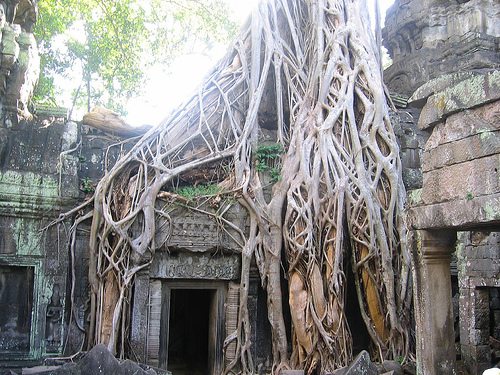
Banyan tree (or is it silk-cotton tree?) in the ruins of Ta Prohm, Ankor, Cambodia
(Image Credit: Casual Chin [flickr])
One of the most famous species of Banyan, called the Sacred Fig [wiki] or Bo tree, is the Sri Maha Bodhi [wiki] tree in Anuradhapura, Sri Lanka. It is said that the tree was grown from a cutting from the original tree under which Buddha became enlightened in the 6th century BC.
Planted in 288 BC, it is the oldest living human-planted tree in the world, with a definitive planting date!
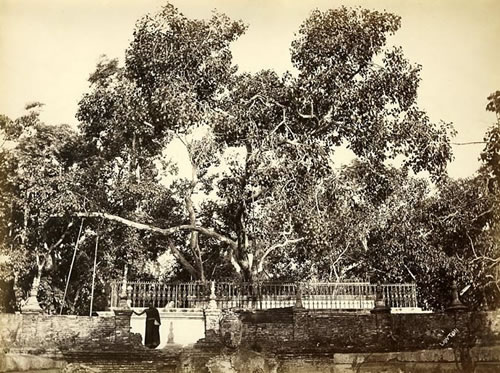
(Image credit: Images of Ceylon)
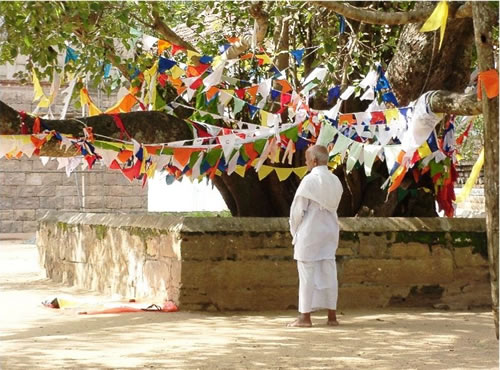
(Image credit: Wikipedia)
2. Bristlecone Pine: Methuselah and Prometheus, the Oldest Trees in the World.
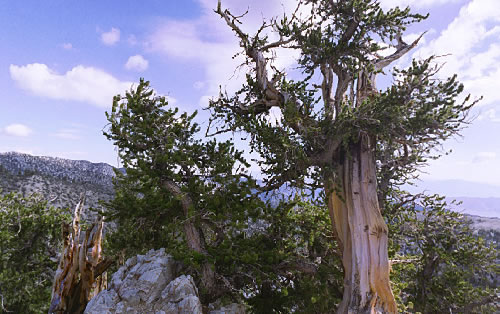
Methuselah Grove (Image Credit: NOVA Online)
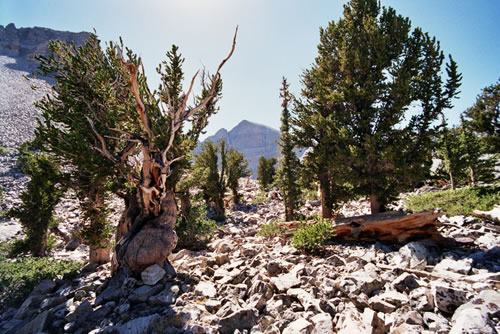
Bristlecone pine grove in which Prometheus grew (Image credit: James R. Bouldin, Wikipedia)
The oldest living tree in the world is a White Mountains, California, bristlecone pine (Pinus longaeva) named Methuselah [wiki], after the Biblical figure who lived to 969 years old. The Methuselah tree, found at 11,000 feet above sea level, is 4,838 years old - it is not only the oldest tree but also the oldest living non-clonal organism in the world.
Before Methuselah was identified as the world's oldest tree by Edmund Schulman in 1957, people thought that the Giant Sequoias were the world's oldest trees at about 2,000 years old. Schulman used a borer to obtain a core sample to count the growth rings of various bristlecone pines, and found over a dozen trees over 4,000 years old.
The story of Prometheus [wiki] is even more interesting: in 1964, Donald R. Currey [wiki], then a graduate student, was taking core samples from a tree named Prometheus. His boring tool broke inside the tree, so he asked for permission from the US Forest Service to cut it down and examine the full cross section of the wood. Surprisingly the Forest Service agreed! When they examined the tree, Prometheus turned out to be about 5,000 years old, which would have made it the world's oldest tree when the scientist unwittingly killed it!
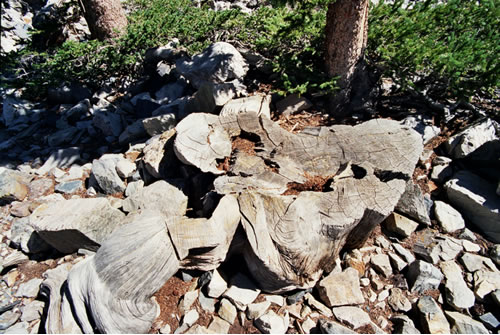
Stump of the Prometheus Tree. (Image Credit: James R. Bouldin, Wikipedia)
Today, to protect the trees from the inquisitive traveler, the authorities are keeping their location secret (indeed, there are no photos identifying Methuselah for fear of vandalism).
1. Baobab
The amazing baobab [wiki] (Adansonia) or monkey bread tree can grow up to nearly 100 feet (30 m) tall and 35 feet (11 m) wide. Their defining characteristic: their swollen trunk are actually water storage - the baobab tree can store as much as 31,700 gallon (120,000 l) of water to endure harsh drought conditions.
Baobab trees are native to Madagascar (it's the country's national tree!), mainland Africa, and Australia. A cluster of "the grandest of all" baobab trees (Adansonia grandidieri) can be found in the Baobab Avenue, near Morondava, in Madagascar:
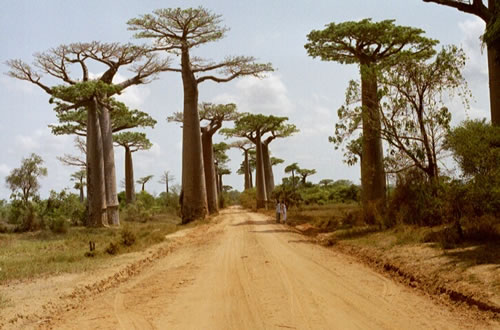
(Image credit: Fox-Talbot, Wikipedia)
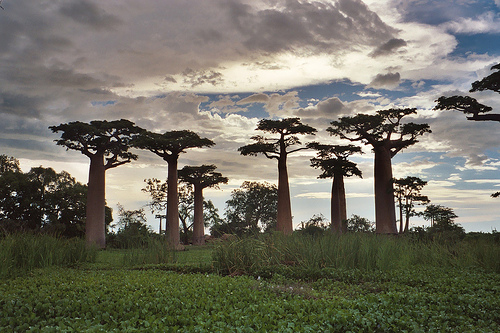
(Image credit: plizzba [flickr])
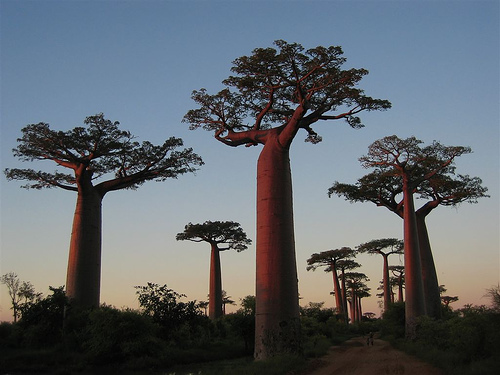
(Image credit: Daniel Montesino [flickr])
In Ifaty, southwestern Madagascar, other baobabs take the form of bottles, skulls, and even teapots:
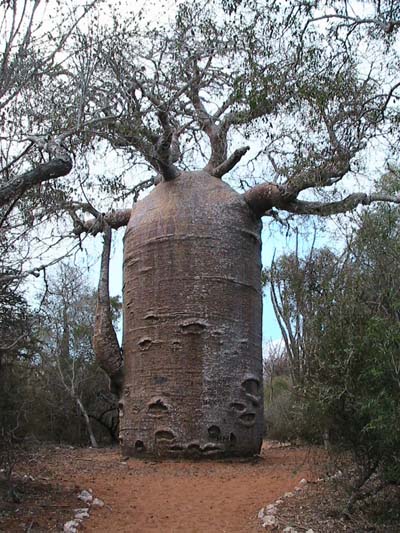
Teapot baobab (Image credit: Gilles Croissant)
The baobab trees in Africa are amazing as well:
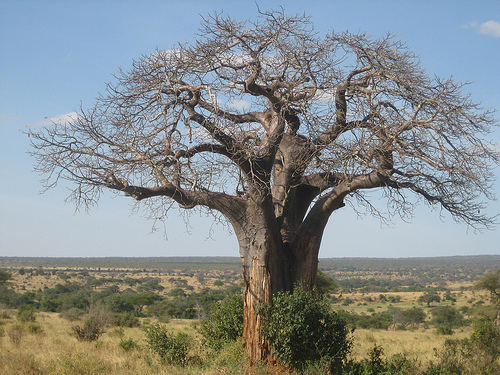
Baobab in Tanzania (Image credit: telethon [flickr])
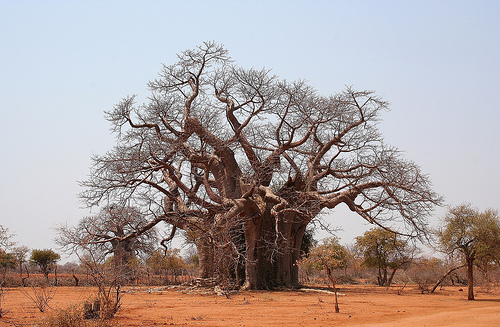
Baobab near Bulawayo, Zimbabwe (Image credit: ironmanix [flickr])
There are many practical uses of baobab trees, like for a toilet:
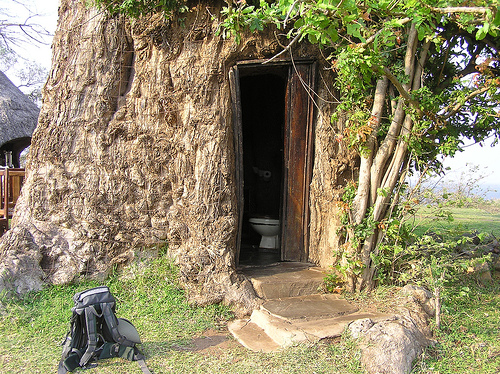
A toilet built inside a baobab tree in the Kayila Lodge, Zambia
(Image credit: Steve Makin [flickr])
... and even for a prison:
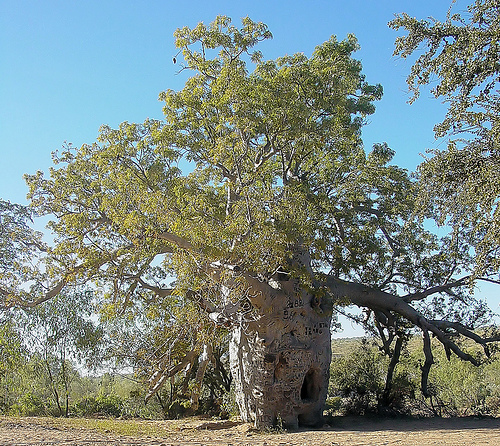
A "Prison Baob" tree in Western Australia (Image credit: yewenyi [flickr])
Bonus: Tree That Owns Itself
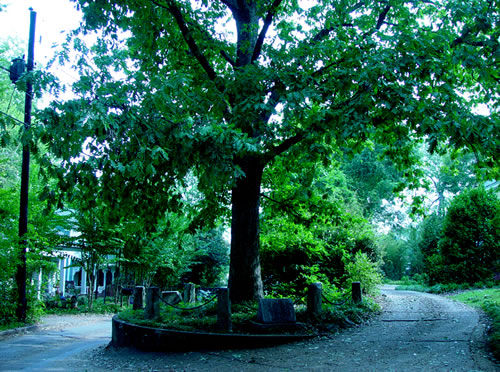
Son of the Tree That Owns Itself (Image Credit: Bloodofox, Wikipedia)
Legend has it that the Tree That Owns Itself [wiki], a white oak in Athens, Georgia was given ownership of itself and the surrounding land by Dr. William Henry Jackson in 1820! The original tree had died long ago, but a new tree (Son of The Tree That Owns Itself) was planted at the same location from one of its acorns.
Bonus 2: The Lonely Tree of Ténéré
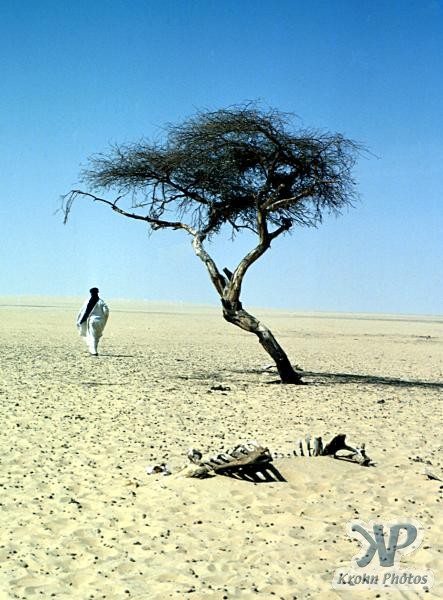
The Tree of Ténéré in the 1970s, before a truck crashed into it (Image credit: Peter Krohn)
The Tree of Ténéré or L'Abre du Ténéré was the world's most isolated tree - the solitary acacia, which grew in the Sahara desert in Niger, Africa, was the only tree within more than 250 miles (400 km) around.
The tree was the last surviving member of a group of acacias that grew when the desert wasn't as dry. When scientists dug a hole near the tree, they found its roots went down as deep as 120 feet (36 m) below to the water table!
Apparently, being the only tree in that part of the wide-open desert (remember: there wasn't another tree for 250 miles around), wasn't enough to stop a drunk Libyan truck driver from driving his truck into it, knocking it down and killing it!
Now, a metal sculpture was placed in its spot to commemorate the Lonely Tree of Ténéré:

(Image credit: Nomad's Land, main website)
I'll be the first to acknowledge that this list is far from complete: there are many more magnificent trees in the world (for instance, see the List of Famous Trees [wiki]). If you have any addition of noteworthy tree (and stories about trees), please leave it in the comment section.

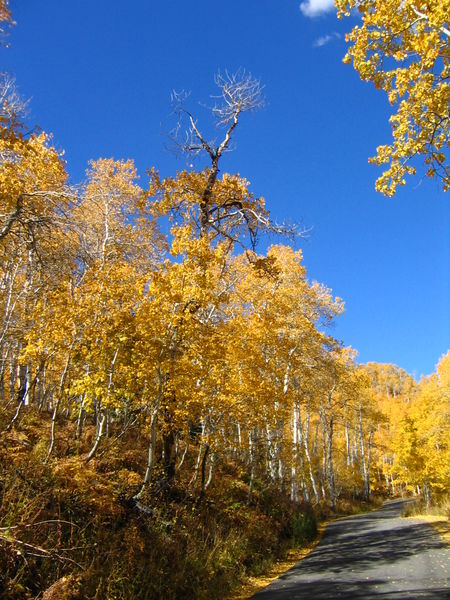





And of course the old Ponderosa Pine in our back yard my dad built a fort in. ;-)
:p
also, i wouldnt say the pacific ocean as a background is more beautiful than the lone cypress (the ocean is just sploshing liquid - whereas the tree is a living thing!) :)
there's a quite famous tree near where i live, is supposedly where robin hood lived - http://en.wikipedia.org/wiki/Major_Oak
but Banyan Tree and Sri Maha Bodhi Tree is different.
last two pictures are of Sri Maha Bodhi Tree.
It's a tree that comes from a part of the original tree that Lord Budda attended enlightment.
http://en.wikipedia.org/wiki/Eucalyptus_regnans
Eucalyptus regnans is the tallest of all flowering plants, and possibly once the tallest of all plants. The tallest measured specimen is officially taken as 114.3 metres. The tree, Cornthwaite Tree or Thorpdale Tree, was first measured by theodolite in 1880. Next year it was felled and then measured by tape and there was close agreement. (Ken J. Simpfendorfer. "Big Trees in Victoria"). The stump commemorated with an insignificant plaque that exists today. The tree was about 1 metre shorter than the world's current tallest living tree, a Coast Redwood, 115.55 metres. The tallest specimens encountered by early European settlers are now dead as a result of bushfires, logging and advanced age. The tallest measured living specimen, Icarus Dream, was rediscovered in Tasmania in January, 2005 and is 97 metres high (Tasmanian Giant Trees Consultative Committee, ref. 1). It was first measured by surveyors at 98.8 metres in 1962 but the documentation had been lost. 15 living trees in Tasmania have been reliably measured in excess of 90 metres (Tasmanian Giant Trees Consultative Committee, ref. 3). Few living specimens in Victoria exceed 90 metres; old records of logged trees make varied claims of extreme heights, but these are difficult to verify today. The famous Ferguson Tree, a specimen in Victoria that fell after a bushfire, was measured by tape by a government surveyor, William Ferguson, on 21 February 1872, at 133 metres (436 feet), though this figure is not now generally accepted. Its crown had broken off and the diameter of the trunk at that point was still one metre, leading to claims that when it was intact the tree would have exceeded 150 metres (500 feet); this however presupposes that the break occurred in a hitherto undamaged tree. A more realistic scenario is of a shorter tree with several episodes of breakage and regrowth building up a stout stem without at any time attaining the claimed height.
(text and images from http://www.blurrytravel.com/sea2003/journal/01282003/01282003.html, browse down to Sai Ngam) or search Sai Ngam:
"One of the unexpected delights of Phimai was a visit to the nearby Sai Ngam (meaning "Beautiful Banyan"), Thailand's oldest and largest banyan tree. Sai Ngam covers 15,000 square meters (49,200 square feet). At first glance, it looks like a collection of many trees, but on closer inspection, you realize that each "tree" is in fact connected, creating one massive banyan tree. This tree is so large that it has become a popular picnic spot for Thais and a small temple has even been built within its complex system of branches."
http://en.wikipedia.org/wiki/Angel_Oak
http://www.montereymedia.com
http://www.natal-brazil.com/portugues/entretenimentos/cajueiro-pirangi.html
Check the last picture in the page. That huge green area? That's one single tree.
Don't forget the Fortingall Yew which is not spectacular to view now after decay and vandalism (souvenir trade), but it is magnificent to comprehend it as the oldest tree in Europe - conservatively aged at 2000 years. It once had a girth of 52 feet. One thing in this tree's favour is that it is relatively easy to access via road.
http://en.wikipedia.org/wiki/Dracaena_draco
There is one in "Icod de los Vinos" that is called the millenary Draco, but it's *only* about 650 years old
Nice collection.
http://www.angeloaktree.org/angel17.jpg
Thanks,
That is in Andhra Pradesh, India. Sorry I couldn't find the pictures off hand. i will try to post them
http://en.wikipedia.org/wiki/Treaty_Oak,_Austin
http://www.eyemead.com/majoroak.htm
Kind regards,
Bryan
http://en.wikipedia.org/wiki/Agathis
However, it would have been nice if the information was free of spelling and grammatical errors.
Thank you.
Joshua Powell - sorry, I don't use RSS much so I don't know how it works for you. Your complaint is actually the first I've received for long articles (there had been many on Neatorama).
Sri Lanka - Bo tree is a species of banyan.
Teacher - thank you. I'm a bad spelor and even am worsening a grammarian. :) If you point out the mistakes, I'll be happy to edit the post.
Link
http://lowing.org/mexico/IMG_4711.JPG
Batopilas, Shepherd's Castle, Silver Canyon Mexico:
http://lowing.org/mexico/IMG_0624.JPG
Tree of Life, Bahrain:
http://k43.pbase.com/u37/bmcmorrow/upload/32346375.bahrain470.JPG
other than that, great post.
Also, the credit for images found on Wikipedia does not belong to "Wikipedia" - it belongs to the individual photographer. You can find who to credit by clicking on the photo. Thanks.
Would you drive your car through the Sistine Chapel? No! Why? Because it's sacred! Redwoods are (should be) sacred, too. Drive-through trees are a desecration and shouldn't be celebrated.
Tourists drove to Sequoia National Park looking through a drive-through tree, and when we don't them there wasn't one, they freaked out and exclaimed, "We came all this way for nothing!"
They sure did.
The "Seven Sisters Oak" in Lewisberg, Louisiana is believed to be approx. 1,500 years old and has a girth of over 38 feet. It's also president of the Live Oak Society. You can learn more here:
http://www.louisianagardenclubs.org/pages/oak.htm
Steve - I think it's clearer to use "wiki" to denote wikipedia than "WP". I've corrected some of the image credits which I found on Wikipedia - a couple came with user info and credit (in the file history), some did not.
Ranger X - the hole-cutting of the drive-thru trees was done a loooong time ago. Although of course I do not advocate cutting one now, these trees are part of the attractions of the national parks. Your visitor must have been thinking of the Wawona Tree.
"A tree is a tree. How many more do you have to look at?" -- Ronald Reagan, 1966, opposing expansion of Redwood National Park as governor of California
here ya go!
http://www.flickr.com/photos/johnmcdonald/230700181/
http://de.wikipedia.org/wiki/Bild:Linde_von_linn.jpg
http://www.answersingenesis.org/creation/v17/i3/living_tree.asp
On a wild Tasmanian mountain there is a magnificent, recently discovered stand of Huon pine trees that has been called the world's 'oldest known living organism'. Newspaper reports have claimed that what looks like hundreds of trees densely covering one hectare (2.5 acres), is all part of the one tree, since all these 'trees' appear to have identical DNA. Over the years, it is believed, 'snow has forced its branches to the ground, where they have taken root'. (The Sydney Morning Herald, January 28, 1995, page 1.)
I just finished reading Robinson Crusoe (today), and I don't think he made a treehouse. He made a cave! In The Swiss Family Robinson the family makes a treehouse. Perhaps you are thinking of them?
These show art of the nature at its best...
In Tasmania Australia there is a tree cannled the Tasmanian Huon pine tree.
It is reported by some to be around 10,000 years old.... (although the individual may only be 3,000 years old)
just thought you may like to know
http://www.natal-brazil.com/entertainment/cashew-tree.html
http://www.treklens.com/gallery/North_America/United_States/Other/photo94982.htm
I grew up not too far from it.
http://recursos.cnice.mec.es/bancoimagenes2/buscador/imagen.php?idimagen=3892&zona=mat&nivel1=95&start=17680
www.rinconcitocanario.com/plantas/pag6/drago.htm
http://www.championtrees.org/champions/kauriNZ.htm
The world's largest rainforest tree, Tane Mahuta stands guard over Waipoua and has become an icon of New Zealand's unique natural heritage. At the time of Christ, Tane Mahuta was already a mature tree. It had seen 1000 years of history before man colonised New Zealand, the last major land mass to be inhabited by humans. It knew the ancient world of the moa, giant eagle and huia.
Awesome, and if you drive from the north, as you approach it, it toweres above everything else.
http://www.cuervoblanco.com/arboles_monumentales.html
Great post.
Some incredible examples of human stupidity
http://www.stephanieblakey.me.uk/alphabets/trees.html
I appreciate the time and effort your took in this post. Thanks.
Hope you will update the site constantly with new and amazing trees.
Your friend in Malaysia,
Pepper Lim
Tharanga Wijethilake
Peace,
AkuaKathleen
~The Angel Power Emporium~
I think this topic could create an interesting blog of it's own: a blog of incredible trees.